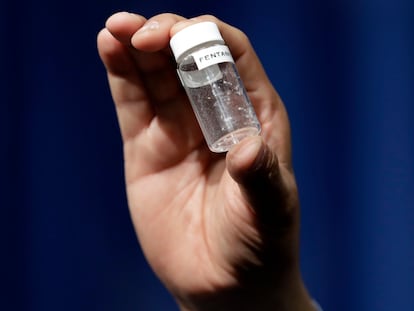Rainbow fentanyl: US sounds alarm over teen overdoses
The DEA has investigated 390 cases in the past four months, 35 of which are directly tied to the two largest criminal organizations in Mexico: the Sinaloa Cartel and the CJNG


In mid-September, a 15-year-old teenager died in a bathroom at her Hollywood high school from a fentanyl overdose. Three other students from the same school were admitted to a hospital after ingesting pills bought in a park near the school. At least seven teenagers between the ages of 15 and 17 have overdosed on this powerful synthetic opiate in Los Angeles over the past few weeks. The drug, which killed more than 70,600 Americans last year, continues to extend its reach in the United States, where it is leaving a trail of destruction in its wake. The growing number of overdoses has sparked alarm within the US government and the Drug Enforcement Agency (DEA), which is especially concerned about so-called “rainbow fentanyl” – candy-colored pills targeted at teens.
At the end of August, officers from the Maricopa County Sheriff’s Office in Arizona arrested two women aged 26 and 19, who were carrying 850,000 fentanyl pills in two suitcases. The women were heading to Phoenix when they were arrested in Gila Bend, a town 81 miles (130 kilometers) from the Mexican border. A prosecutor said the pills were being sold in bright “candy-like” colors to attract youngsters.
One Monday, US Attorney General Merrick Garland blamed the Mexican cartels for the fentanyl crisis. In a conference with the head of the DEA, Anne Milgram, he reported that authorities had investigated 390 fentanyl-linked cases over the past four months, 51 of them linked to overdoses and 35 tied directly to the Jalisco New Generation Cartel (CJNG) and the Sinaloa Cartel, the two largest criminal organizations in Mexico.
On Tuesday, Garland and Milgram offered a tour of the DEA headquarters, which features a special exhibit called “The Faces of Fentanyl” in tribute to those who lost their lives from fentanyl poisoning, including country singer Luke Bell and the son of writer Paul Auster, Daniel. Fentanyl is now the number one cause of death for Americans aged between 18 and 45.
“The most urgent threat to our communities, our kids, and our families are the Sinaloa Cartel and CJNG, who are mass producing and supplying the fentanyl that is poisoning and killing Americans,” said Milgram. Fentanyl is 50 times more powerful than heroin and 100 times more powerful than morphine. According to authorities, just two milligrams – the equivalent of 15 grains of table salt – is enough to kill a person.
In the past four months, US authorities have seized 10.2 million fentanyl pills and approximately 980 pounds of fentanyl powder. “The amount of fentanyl taken off the streets during this surge is equivalent to more than 36 million lethal doses removed from the illegal drug supply,” the DEA reported in a press release on Tuesday.
Authorities are especially concerned about the rise of rainbow fentanyl. In February, the DEA warned that the synthetic opiate could be sold in bright colors, sizes and shapes. Since then, rainbow fentanyl has been detected in 21 US states.
Conservative media have also jumped on the issue. Fox News presenters suggested that children should not be allowed to go trick-or-treating on Halloween due to the problem, while Jeanine Pirro, the TV host of The Five, blamed the crisis on President Joe Biden and China, which produces the drug. “It is an undeclared war by China against Americans, now American children,” she said on the program on Tuesday. “And if they cared, the president would stop the influx of the fentanyl dealing that is coming from the southern border.”
Tu suscripción se está usando en otro dispositivo
¿Quieres añadir otro usuario a tu suscripción?
Si continúas leyendo en este dispositivo, no se podrá leer en el otro.
FlechaTu suscripción se está usando en otro dispositivo y solo puedes acceder a EL PAÍS desde un dispositivo a la vez.
Si quieres compartir tu cuenta, cambia tu suscripción a la modalidad Premium, así podrás añadir otro usuario. Cada uno accederá con su propia cuenta de email, lo que os permitirá personalizar vuestra experiencia en EL PAÍS.
¿Tienes una suscripción de empresa? Accede aquí para contratar más cuentas.
En el caso de no saber quién está usando tu cuenta, te recomendamos cambiar tu contraseña aquí.
Si decides continuar compartiendo tu cuenta, este mensaje se mostrará en tu dispositivo y en el de la otra persona que está usando tu cuenta de forma indefinida, afectando a tu experiencia de lectura. Puedes consultar aquí los términos y condiciones de la suscripción digital.
More information
Archived In
Últimas noticias
Maduro pleads not guilty before the federal court in New York: ‘I am still the president of Venezuela’
A new test can detect Alzheimer’s from a finger prick
UN team enters Sudanese city of El Fasher after paramilitary massacre: ‘It’s like a ghost town’
A recipe for resistance: Indigenous peoples politicize their struggles from the kitchen
Most viewed
- Gilles Lipovetsky: ‘If you want to live better and fall in love, take Prozac, don’t look to philosophy’
- Alain Aspect, Nobel laureate in physics: ‘Einstein was so smart that he would have had to recognize quantum entanglement’
- Alvin Hellerstein, a 92-year-old judge appointed by Bill Clinton, to preside over Maduro’s trial in New York
- Why oil has been at the center of Venezuela-US conflicts for decades
- Cuba confirms death of 32 of its citizens in the US attack against Venezuela










































